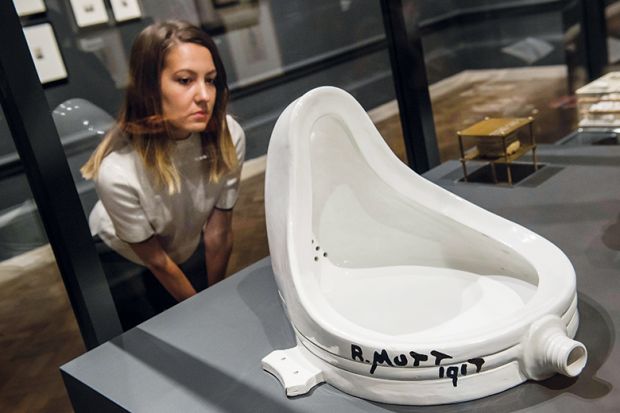In 1917, Marcel Duchamp famously submitted a mass-produced urinal to an open exhibition sponsored by the Society of Independent Artists. The committee was not impressed, declaring that Fountain “may be a very useful object in its place, but its place is not an art exhibition, and it is by no definition, a work of art”. Duchamp responded by claiming that he had transformed a found object – one decidedly not of his own making – into art through the deceptively simple act of designating it so.
This provocation on the nature of authorship and aesthetic judgement appears late in Leonard Diepeveen’s sprightly, stimulating book, which plumbs the depths of suspicion, ridicule and anger that initially greeted modernist arts. For sceptics, he writes, “modernism was founded on a kind of hoax structure, its badness evincing a dishonest intent to present carelessly produced art – even wilfully bad art – as good art, deserving serious attention”. Fountain’s interpretive crux was “one of intent, a question whether something could be a work of art if it did not have a serious (read: sincere) intent motivating it”.
How did modernism’s first generation of critics position themselves against the inscrutable, elusive, apparently insincere intents of modernist art? The “fraud response” has a complex and varied presence, ranging from straightforward accusations of deceit to parodies and hoaxes that seek to mimic and thus expose imputed modernist intentions. We also find modernist artists themselves deploying the ludic strategies of parody – bathos, excess, citation, juxtaposition, irony – to dissemble their own intent.
Diepeveen has uncovered a massive, unexplored archive, in monographs, anthologies, reviews and newspaper columns, which is flush with witty one-liners – but he elicits more than just good anecdotes. (The drollest sources are collected in his own 2014 collection, Mock Modernism: An Anthology of Parodies, Travesties, Frauds, 1910-1935.) There is a chasm between this kind of writing’s place in early 20th-century mass culture and its absence in today’s critical scholarship. More than recovery and preservation, Diepeveen’s triumph is to probe what “fraud discourse” as an early category of response suggests about modernism’s social presence and ethical function.
Authorial intent has a problematic history in literary studies, fraught both because of its evidentiary challenges and its stubborn persistence. Duchamp’s Fountain might be both a joke and serious, and this uncertainty might be productive, even polemical. But the 20th century’s dominant models for working with artistic intent are not equipped to deal with this kind of situation: either intent matters and must be clear, or it is unknowable and therefore irrelevant. For Diepeveen, this sharp distinction is “too streamlined to account for what art does, and how audiences make it mean”. Modernist fraud is deeply imbricated in the rise of interpretive practices based on understanding the meaning, rather than the effects, of artworks, which is in turn inextricable from the professionalisation of criticism, its establishment in universities and the codification of the canon during the 1920s. It begs the question: in framing literary criticism as chiefly an act of decoding (what Rita Felski has called “suspicious reading”), have we forgotten to respond to art affectively – to be baffled, irate, sceptical; to ask ourselves, beholding once-subversive, now-canonical works, do I actually think this is any good?
Charlotte Jones teaches English literature at King’s College London.
Modernist Fraud: Hoax, Parody, Deception
By Leonard Diepeveen
Oxford University Press
224pp, £55.00
ISBN 9780198825432
Published 13 March 2019
Register to continue
Why register?
- Registration is free and only takes a moment
- Once registered, you can read 3 articles a month
- Sign up for our newsletter
Subscribe
Or subscribe for unlimited access to:
- Unlimited access to news, views, insights & reviews
- Digital editions
- Digital access to THE’s university and college rankings analysis
Already registered or a current subscriber?





